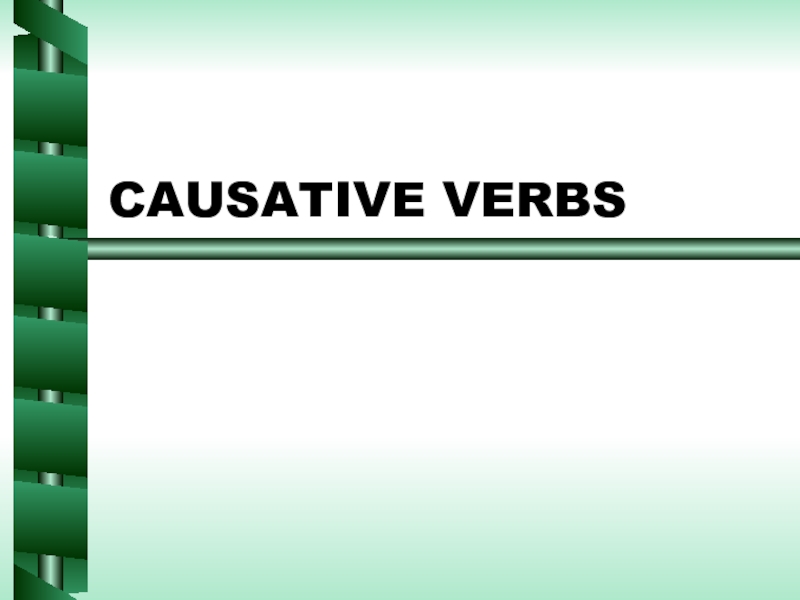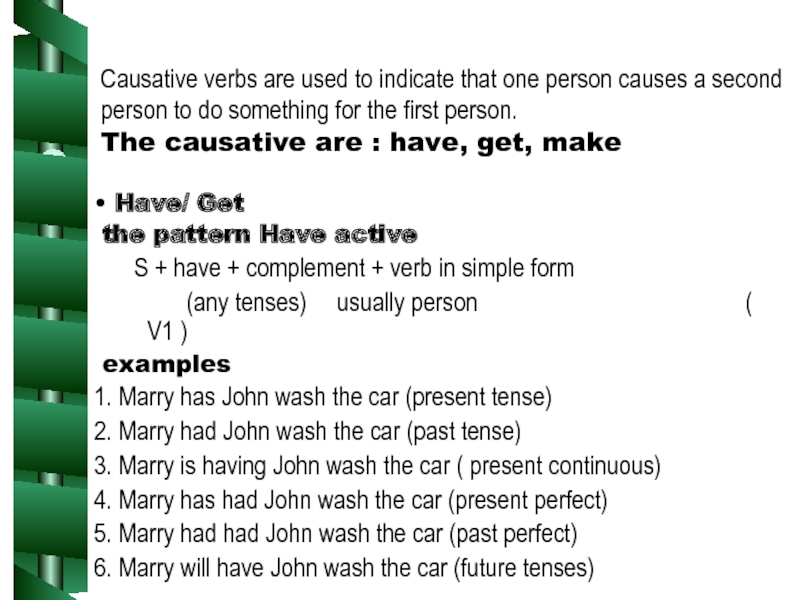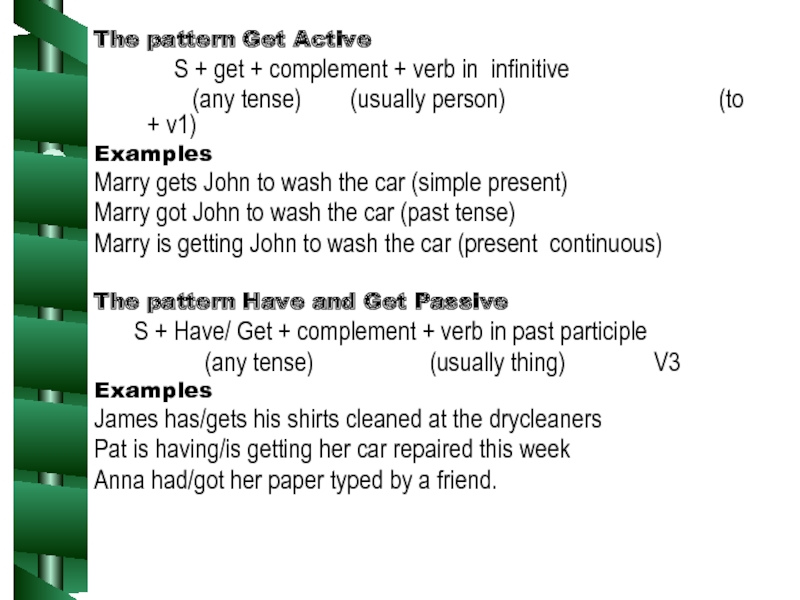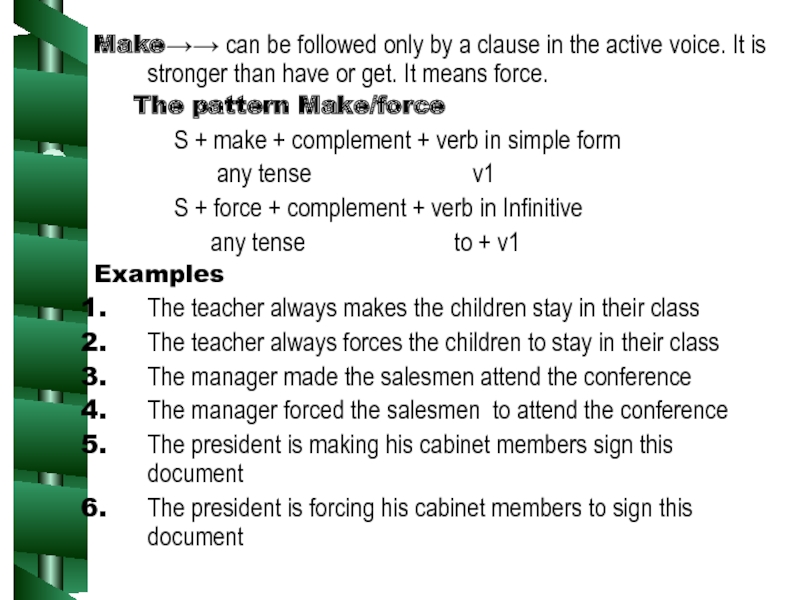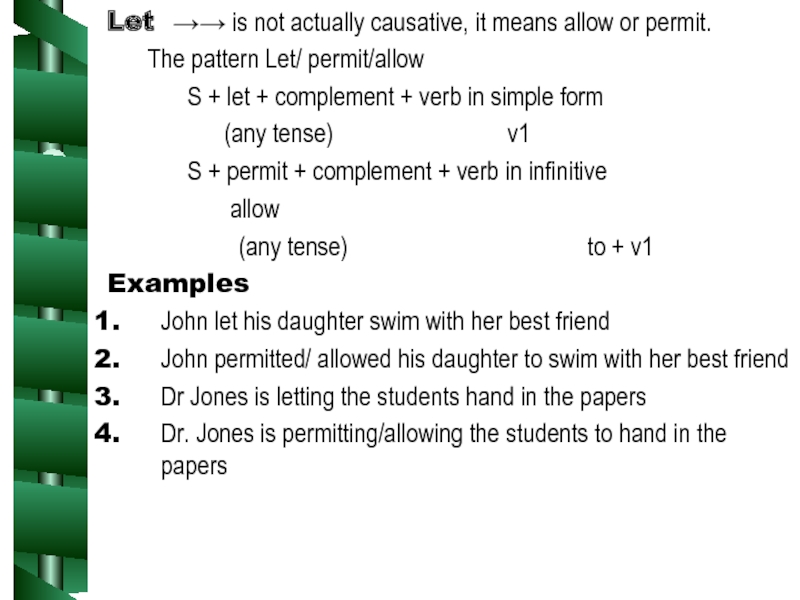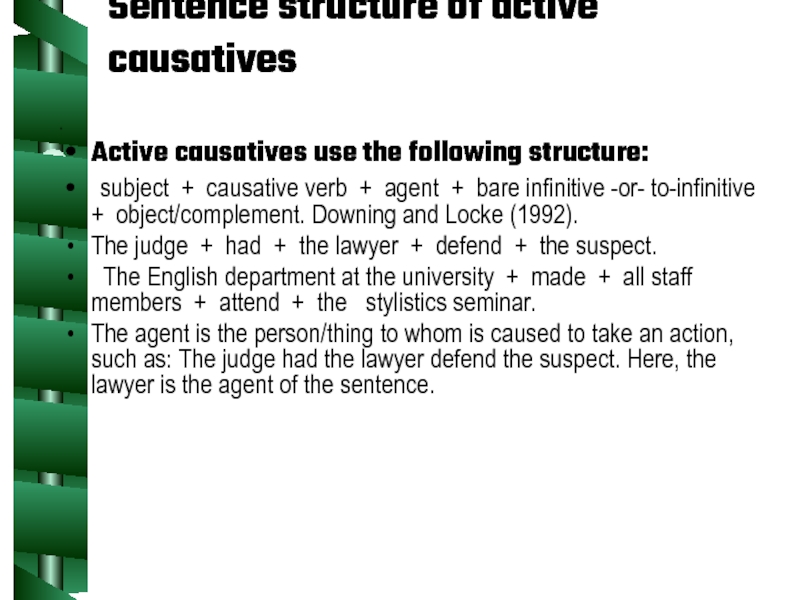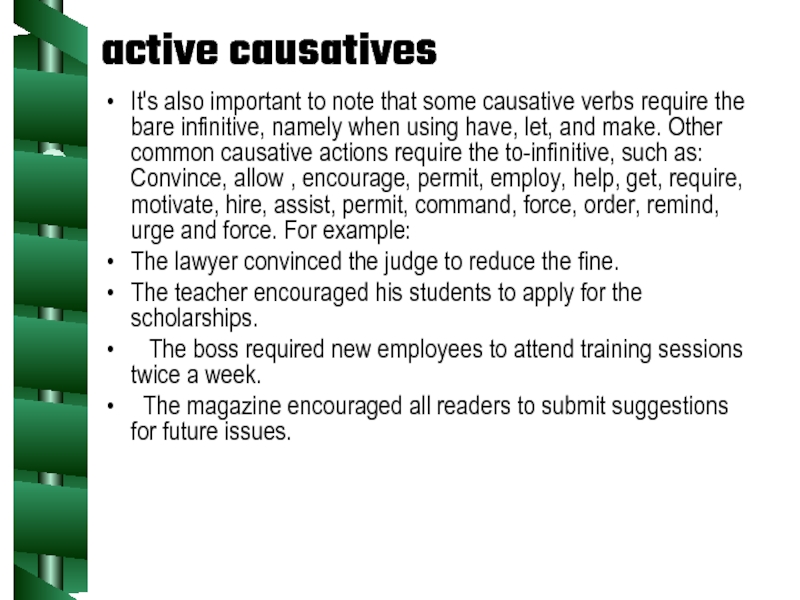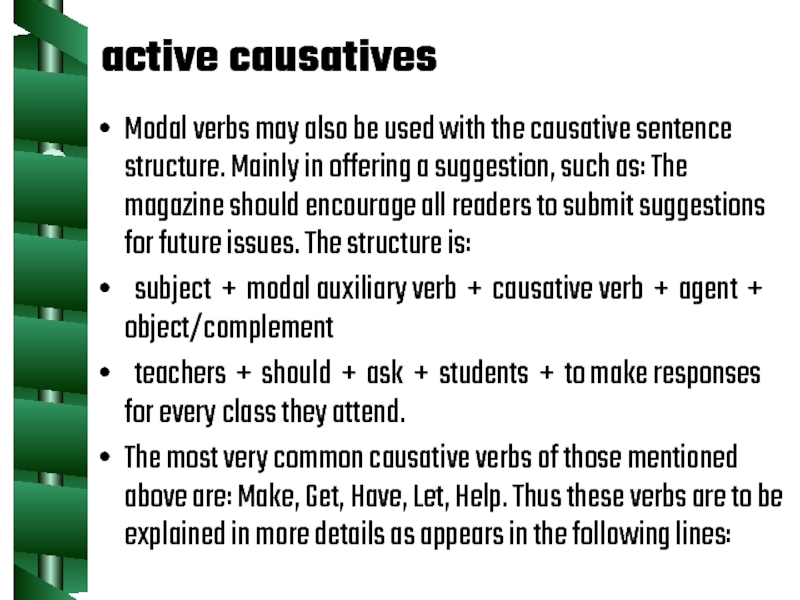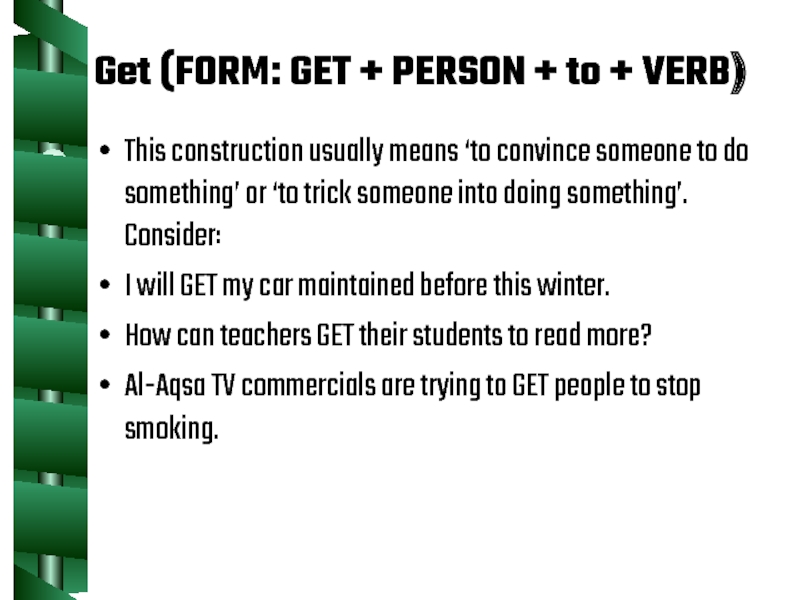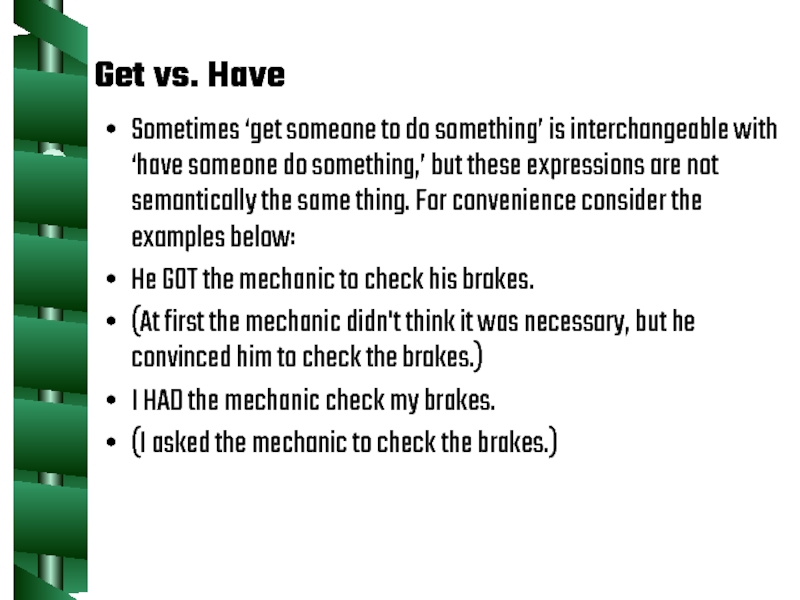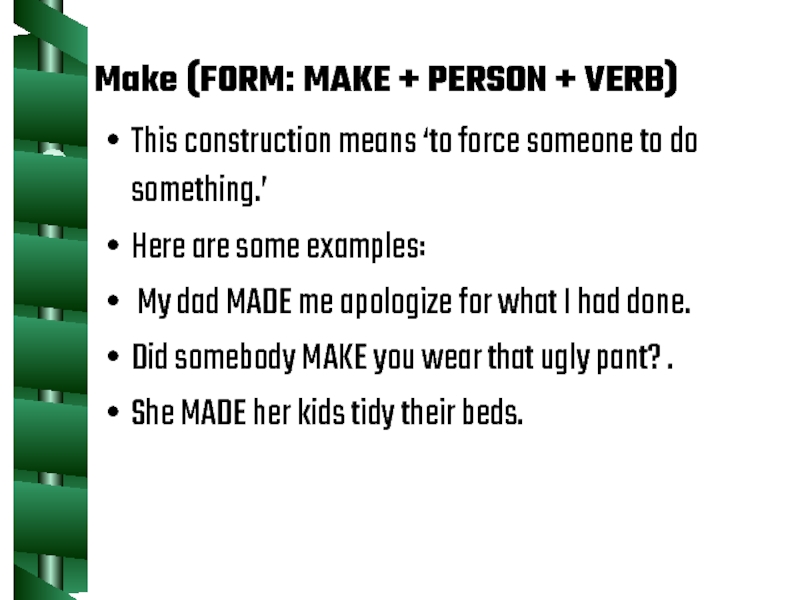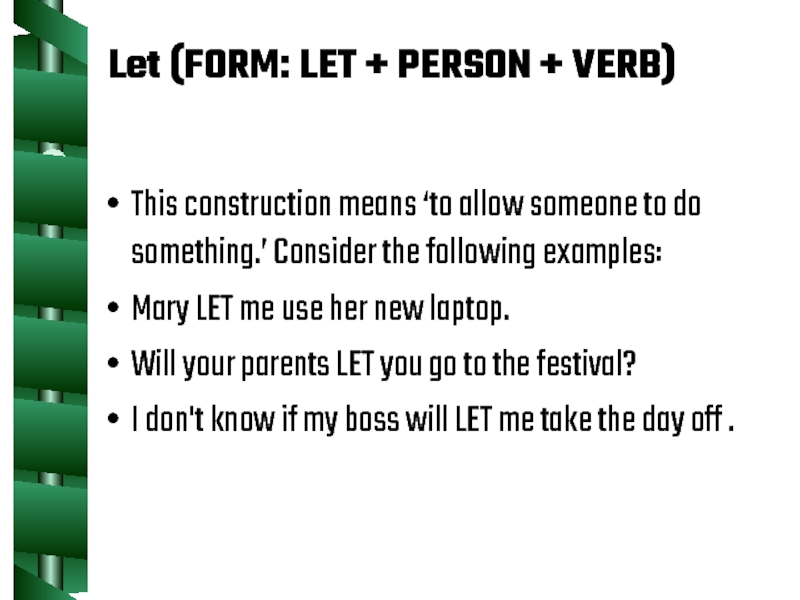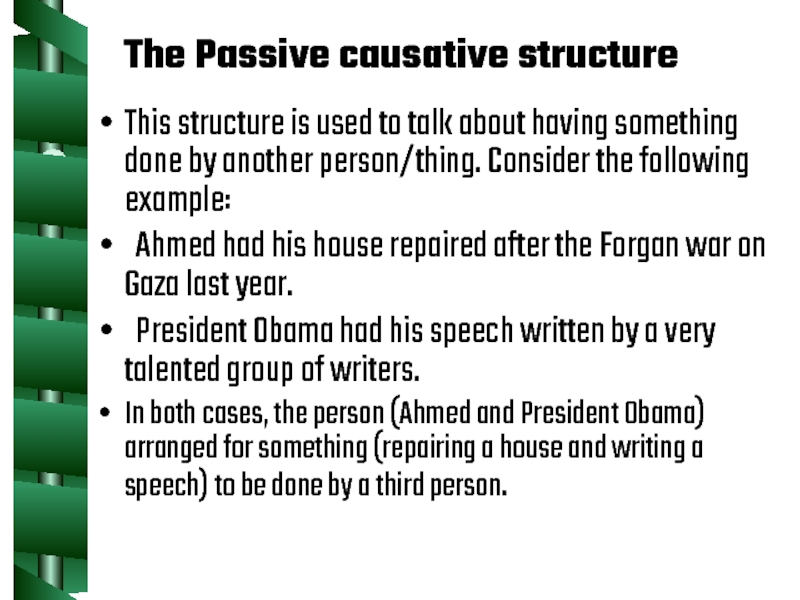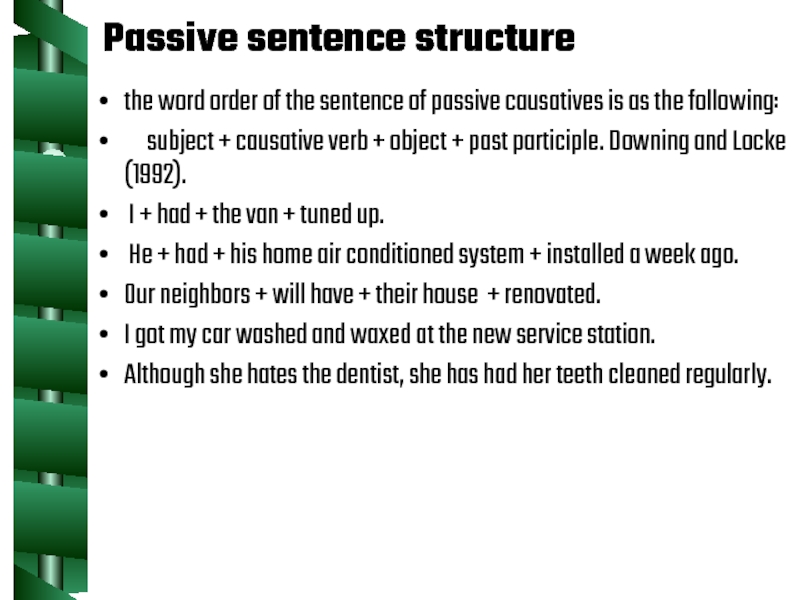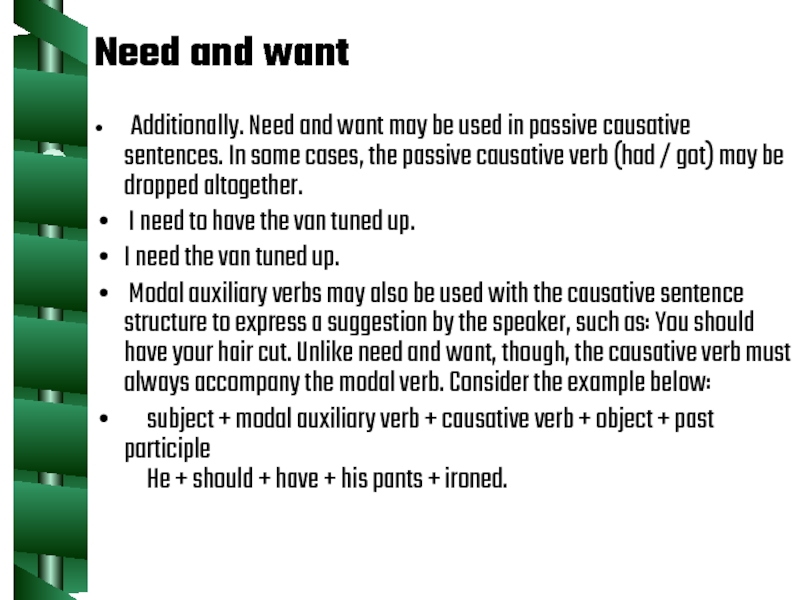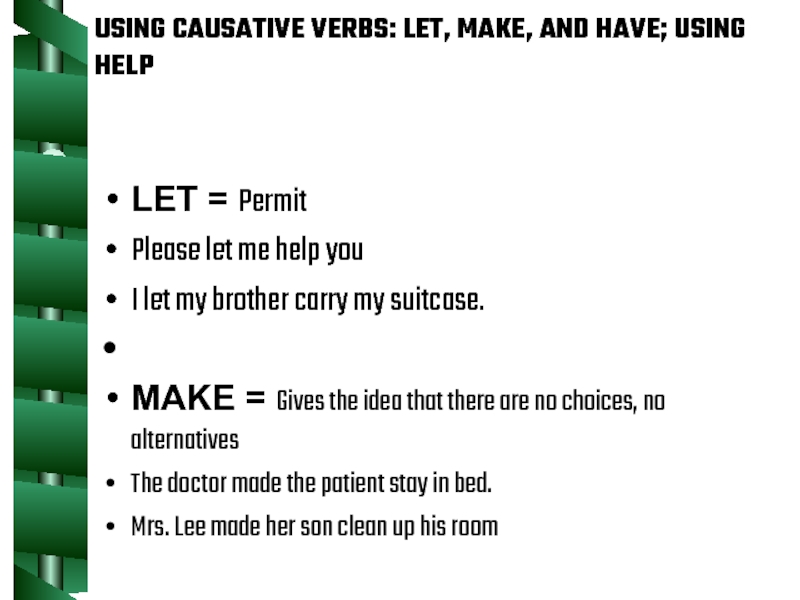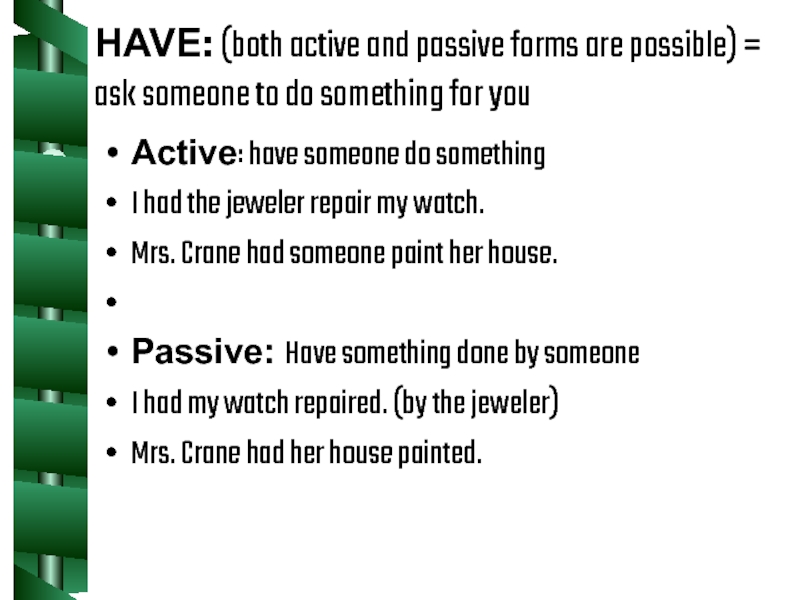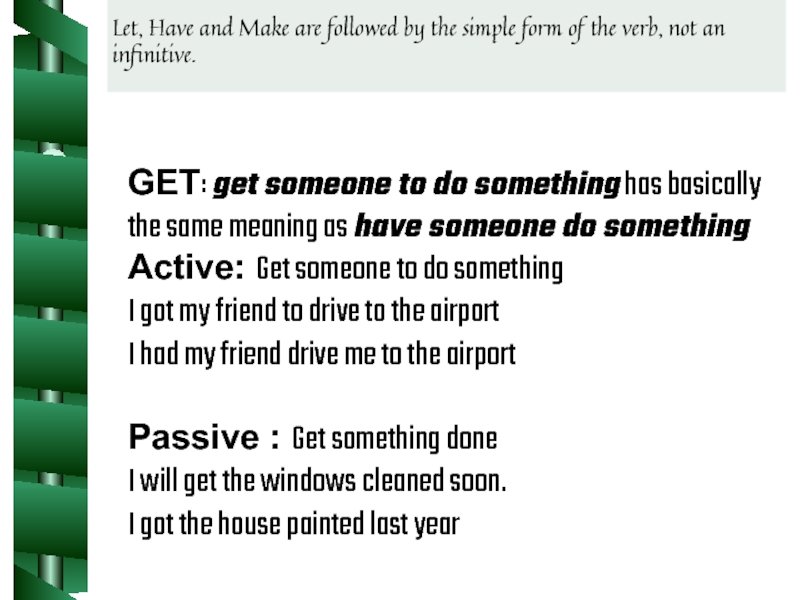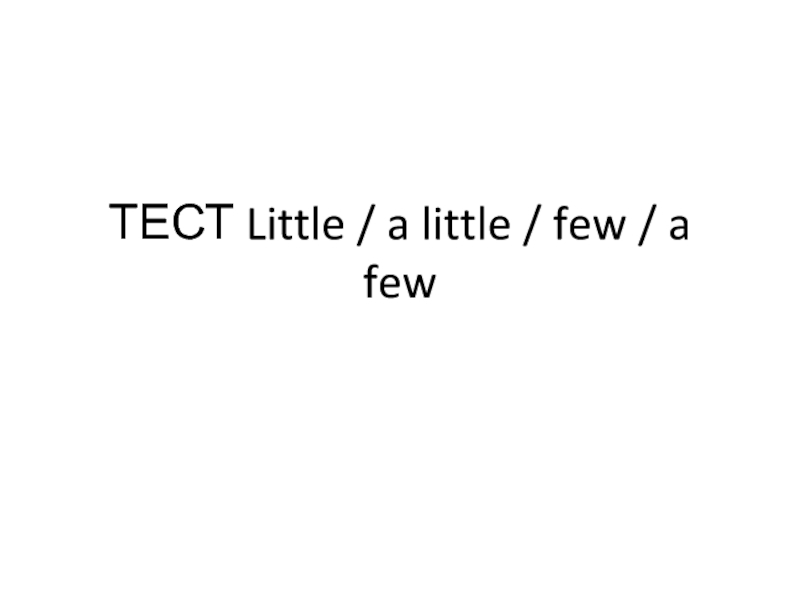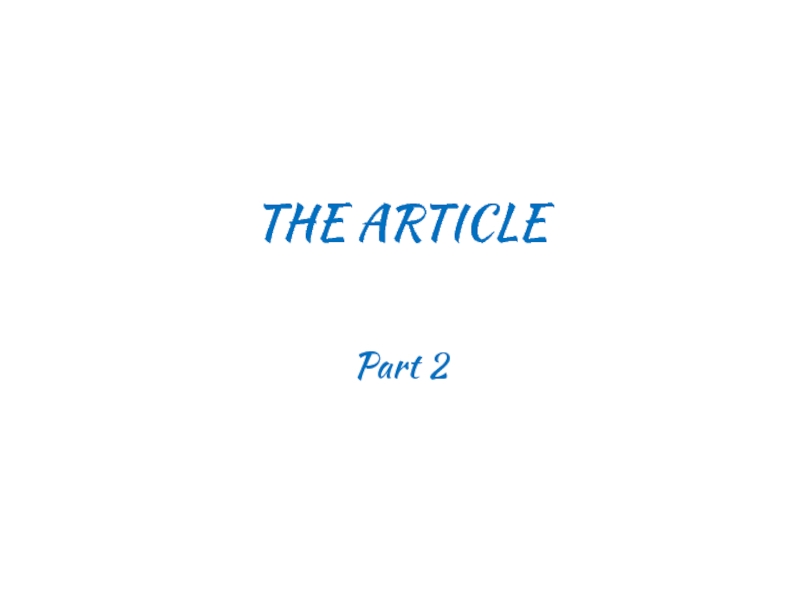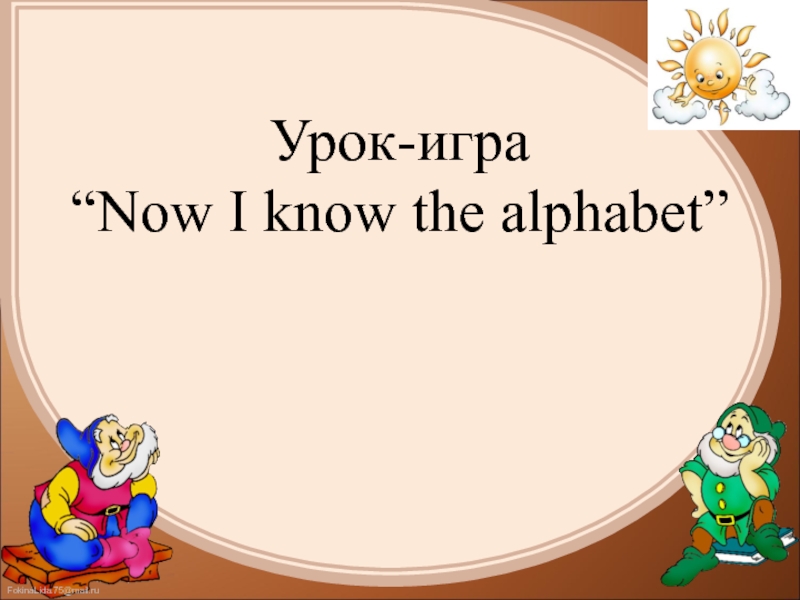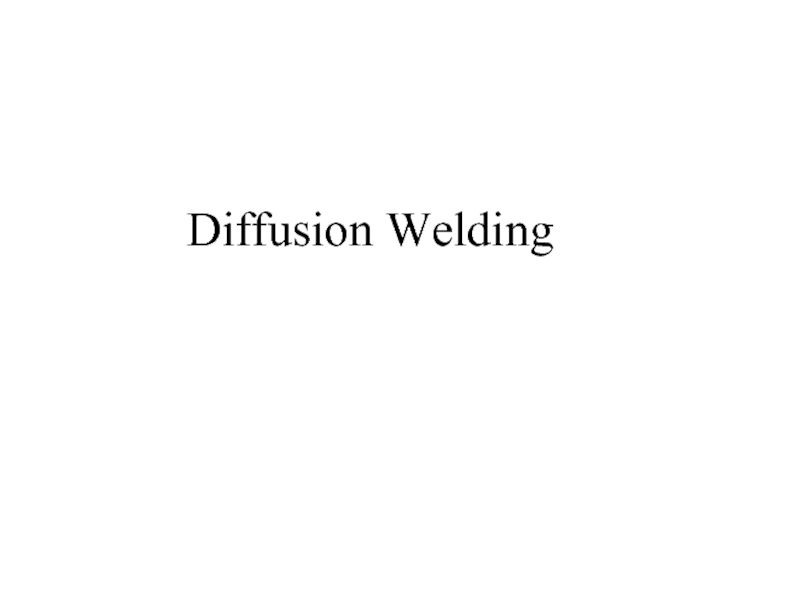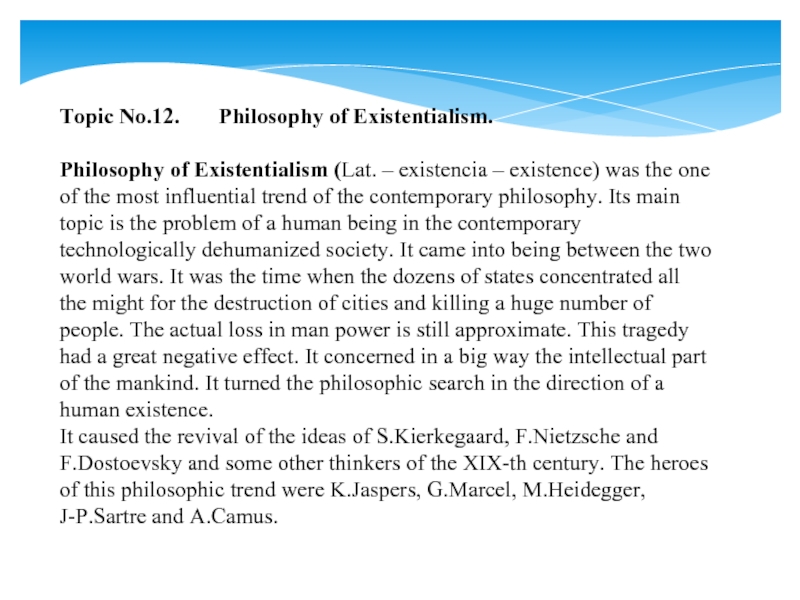- Главная
- Разное
- Дизайн
- Бизнес и предпринимательство
- Аналитика
- Образование
- Развлечения
- Красота и здоровье
- Финансы
- Государство
- Путешествия
- Спорт
- Недвижимость
- Армия
- Графика
- Культурология
- Еда и кулинария
- Лингвистика
- Английский язык
- Астрономия
- Алгебра
- Биология
- География
- Детские презентации
- Информатика
- История
- Литература
- Маркетинг
- Математика
- Медицина
- Менеджмент
- Музыка
- МХК
- Немецкий язык
- ОБЖ
- Обществознание
- Окружающий мир
- Педагогика
- Русский язык
- Технология
- Физика
- Философия
- Химия
- Шаблоны, картинки для презентаций
- Экология
- Экономика
- Юриспруденция
Causative verbs презентация
Содержание
- 1. Causative verbs
- 2. Causative verbs are used to indicate that
- 3. The pattern Get Active S + get
- 4. Make→→ can be followed only by a
- 5. Let →→ is not actually causative, it
- 6. Exercises The teacher made Juan _______ (leave)
- 7. causative verbs: The causative
- 8. Basic causative structures in English. There are
- 9. Sentence structure of active causatives
- 10. active causatives It's also important to note
- 11. active causatives Modal verbs may also be
- 12. Get (FORM: GET + PERSON + to
- 13. Have (FORM: HAVE + PERSON + VERB)
- 14. Get vs. Have Sometimes ‘get someone to
- 15. Make (FORM: MAKE + PERSON + VERB)
- 16. Let (FORM: LET + PERSON + VERB)
- 17. The Passive causative structure This
- 18. Passive sentence structure the word
- 19. Need and want Additionally. Need and
- 20. USING CAUSATIVE VERBS: LET, MAKE, AND HAVE;
- 21. HAVE: (both active and passive forms are
- 22. GET: get someone to do something has
Слайд 2Causative verbs are used to indicate that one person causes a
• Have/ Get
the pattern Have active
S + have + complement + verb in simple form
(any tenses) usually person ( V1 )
examples
1. Marry has John wash the car (present tense)
2. Marry had John wash the car (past tense)
3. Marry is having John wash the car ( present continuous)
4. Marry has had John wash the car (present perfect)
5. Marry had had John wash the car (past perfect)
6. Marry will have John wash the car (future tenses)
Слайд 3The pattern Get Active
S + get + complement + verb in
(any tense) (usually person) (to + v1)
Examples
Marry gets John to wash the car (simple present)
Marry got John to wash the car (past tense)
Marry is getting John to wash the car (present continuous)
The pattern Have and Get Passive
S + Have/ Get + complement + verb in past participle
(any tense) (usually thing) V3
Examples
James has/gets his shirts cleaned at the drycleaners
Pat is having/is getting her car repaired this week
Anna had/got her paper typed by a friend.
Слайд 4Make→→ can be followed only by a clause in the active
The pattern Make/force
S + make + complement + verb in simple form
any tense v1
S + force + complement + verb in Infinitive
any tense to + v1
Examples
The teacher always makes the children stay in their class
The teacher always forces the children to stay in their class
The manager made the salesmen attend the conference
The manager forced the salesmen to attend the conference
The president is making his cabinet members sign this document
The president is forcing his cabinet members to sign this document
Слайд 5Let →→ is not actually causative, it means allow or permit.
The
S + let + complement + verb in simple form
(any tense) v1
S + permit + complement + verb in infinitive
allow
(any tense) to + v1
Examples
John let his daughter swim with her best friend
John permitted/ allowed his daughter to swim with her best friend
Dr Jones is letting the students hand in the papers
Dr. Jones is permitting/allowing the students to hand in the papers
Слайд 6Exercises
The teacher made Juan _______ (leave) the room.
Toshiko had her car
Ellen got Marvin _____ (type) her paper
We got our house _______ (paint) last week
Mark got his transcripts ______ (send) to the university
6. The teacher let Al _____ (leave) the classroom
Слайд 7 causative verbs:
The causative verb is a common structure
Слайд 8Basic causative structures in English.
There are two basic causative structures. One
2.1. Active causative verbs?
This structure is used when someone causes something to happen, or when a person causes another one to take an action. Consider:
Railway station security had everyone show their tickets.
The tutor made his students do an oral interpretation.
I had Bill fix the van. I had the van fixed.
Слайд 9Sentence structure of active causatives
Active causatives use the following structure:
subject + causative verb + agent + bare infinitive -or- to-infinitive + object/complement. Downing and Locke (1992).
The judge + had + the lawyer + defend + the suspect.
The English department at the university + made + all staff members + attend + the stylistics seminar.
The agent is the person/thing to whom is caused to take an action, such as: The judge had the lawyer defend the suspect. Here, the lawyer is the agent of the sentence.
Слайд 10active causatives
It's also important to note that some causative verbs require
The lawyer convinced the judge to reduce the fine.
The teacher encouraged his students to apply for the scholarships.
The boss required new employees to attend training sessions twice a week.
The magazine encouraged all readers to submit suggestions for future issues.
Слайд 11active causatives
Modal verbs may also be used with the causative sentence
subject + modal auxiliary verb + causative verb + agent + object/complement
teachers + should + ask + students + to make responses for every class they attend.
The most very common causative verbs of those mentioned above are: Make, Get, Have, Let, Help. Thus these verbs are to be explained in more details as appears in the following lines:
Слайд 12Get (FORM: GET + PERSON + to + VERB)
This construction usually
I will GET my car maintained before this winter.
How can teachers GET their students to read more?
Al-Aqsa TV commercials are trying to GET people to stop smoking.
Слайд 13Have (FORM: HAVE + PERSON + VERB)
This construction means ‘to authorize
Here are some examples:
The doctor HAD his nurse take the patient's temperature.
Please HAVE your secretary forward me the e-mail.
I HAD the technician check the photocopy machine.
Слайд 14Get vs. Have
Sometimes ‘get someone to do something’ is interchangeable with
He GOT the mechanic to check his brakes.
(At first the mechanic didn't think it was necessary, but he convinced him to check the brakes.)
I HAD the mechanic check my brakes.
(I asked the mechanic to check the brakes.)
Слайд 15Make (FORM: MAKE + PERSON + VERB)
This construction means ‘to
Here are some examples:
My dad MADE me apologize for what I had done.
Did somebody MAKE you wear that ugly pant? .
She MADE her kids tidy their beds.
Слайд 16Let (FORM: LET + PERSON + VERB)
This construction means ‘to allow
Mary LET me use her new laptop.
Will your parents LET you go to the festival?
I don't know if my boss will LET me take the day off .
Слайд 17 The Passive causative structure
This structure is used to talk
Ahmed had his house repaired after the Forgan war on Gaza last year.
President Obama had his speech written by a very talented group of writers.
In both cases, the person (Ahmed and President Obama) arranged for something (repairing a house and writing a speech) to be done by a third person.
Слайд 18 Passive sentence structure
the word order of the sentence of
subject + causative verb + object + past participle. Downing and Locke (1992).
I + had + the van + tuned up.
He + had + his home air conditioned system + installed a week ago.
Our neighbors + will have + their house + renovated.
I got my car washed and waxed at the new service station.
Although she hates the dentist, she has had her teeth cleaned regularly.
Слайд 19Need and want
Additionally. Need and want may be used in
I need to have the van tuned up.
I need the van tuned up.
Modal auxiliary verbs may also be used with the causative sentence structure to express a suggestion by the speaker, such as: You should have your hair cut. Unlike need and want, though, the causative verb must always accompany the modal verb. Consider the example below:
subject + modal auxiliary verb + causative verb + object + past participle He + should + have + his pants + ironed.
Слайд 20USING CAUSATIVE VERBS: LET, MAKE, AND HAVE; USING HELP
LET = Permit
Please
I let my brother carry my suitcase.
MAKE = Gives the idea that there are no choices, no alternatives
The doctor made the patient stay in bed.
Mrs. Lee made her son clean up his room
Слайд 21HAVE: (both active and passive forms are possible) = ask someone
Active: have someone do something
I had the jeweler repair my watch.
Mrs. Crane had someone paint her house.
Passive: Have something done by someone
I had my watch repaired. (by the jeweler)
Mrs. Crane had her house painted.
